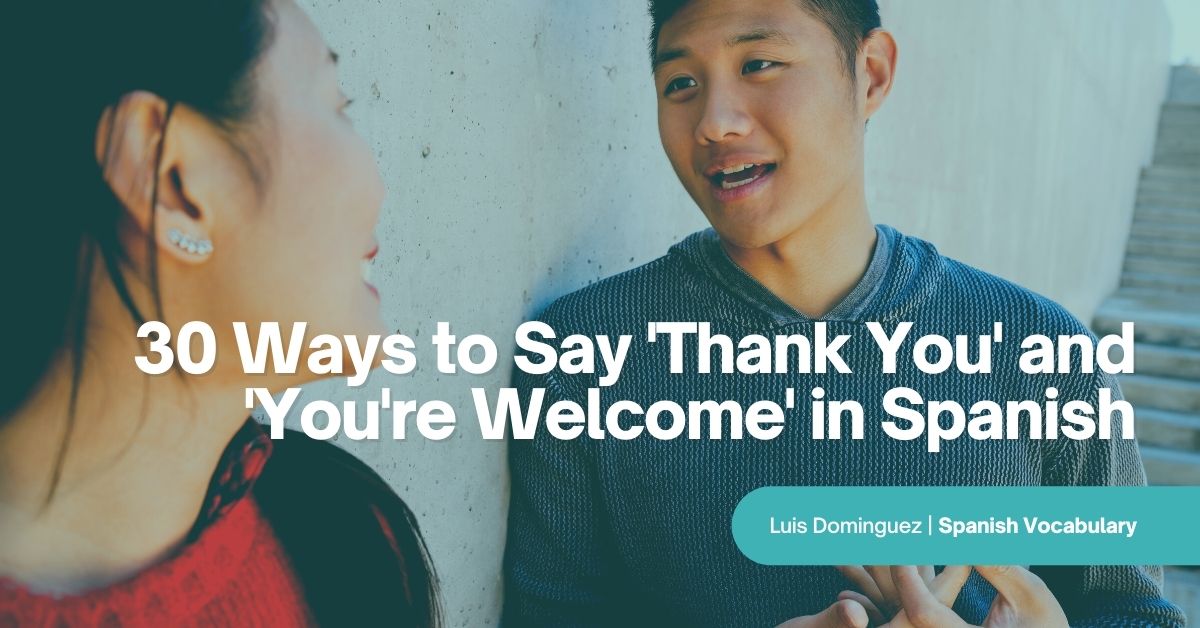
Have you noticed how in English you have a wide variety of ways of saying “thank you,” but in Spanish you only know gracias?
In Spain and Latin America, as in most places, expressing heartfelt gratitude is essential. With the following phrases, you can express those feelings in a variety of ways and in a wide array of situations.
Keep reading to learn more than 30 ways to say “thank you” and “you’re welcome” in Spanish and build your skills to emotionally connect with native Spanish speakers in your conversations.
Table of Contents:
- Life Beyond Gracias and De Nada
- How to Say ‘Thank You’ and ‘You’re Welcome’ in Spanish
- Improve Your Spanish With a Live Instructor
Life Beyond Gracias and De Nada
You likely know that “thank you” in Spanish is gracias. In fact, gracias is one of the first 100 high-frequency words in Spanish, which means it’s surely one of the first words you learned (if you didn’t know it already just from popular culture).
Similar to English, a variety of ways exist to express gratitude to someone. Think about it, you don’t always say “thank you”—sometimes you say “thanks a lot,” other times you may say “I appreciate it,” or some other variation.
In Spanish, it’s the same—there are many ways to say “thank you” and to respond to it.
Are you ready to go beyond gracias and de nada?
Let’s do it! But first, a quick note on formality:
Formal and Informal Language in Spanish
In Spanish, you can use formal or informal language depending on the situation because there are two types of “you”: tú and usted. If you’re talking with your friends, you’d definitely use tú, but if you’re talking with your boss or the school principal, for instance, then you should probably use usted.
This is important, because depending on the kind of “you” that you choose to use, the conjugation of the verbs involved change and the whole phrase adapts accordingly.
This article on how to give compliments in Spanish explains how formality varies depending on the situation. Be sure to keep this in mind when saying “thank you” and “you’re welcome” in Spanish!
How to Say ‘Thank You’ and ‘You’re Welcome’ in Spanish
These 30 ways to say “thank you” and “you’re welcome” in Spanish include slang words, sign language, and English translations.
Listen to this list!
Thank you
Let’s start with all the phrases and expressions to say “thank you” in Spanish.
1. Muchas gracias
Use: formal and informal
Muchas gracias means “thank you very much” or “many thanks.” It’s one of the most common ways to show your thankfulness.
2. Muchísimas gracias
Use: informal
Muchísimas gracias uses the suffix -ísimas, which is a suffix that works as a superlative. It translates to “thank you very, very much.”
3. Mil gracias
Use: informal
This is one of my favorites, it literally translates to “a thousand thank yous.”
4. Un millón de gracias
Use: informal
Similar to the previous one, but in this case the thousand becomes a million. Literally translates to “a million thank yous.”
5. Gracias por todo
Use: informal
Literally, “thank you for everything.” Use it when someone has been helping you constantly and in different ways.
6. Te lo agradezco
Use: formal
Literally translates to “I thank you,” but a more functional translation would be “I appreciate it.” Reserve this phrase for formal or serious occasions.
7. Gracias por la comida
Use: formal
Say this after having lunch or dinner. It means “thanks for the food.” Commonly used when going to eat at someone’s home.
8. Gracias por todo y buen provecho
Use: formal
Keeping with the topic of food, this one is close to my heart. My mom made me say this phrase after every meal. It means “thanks for everything and bon appetit.”
9. Gracias por todo lo que haces
Use: informal
Meaning “thank you for all you do,” this is commonly said between people who have a close relationship, such as couples or family members.
10. Lo aprecio mucho
Use: formal and informal
One of the few versions that doesn’t use the word gracias. This one means “I appreciate it.”
11. Estoy muy agradecido/a
Use: formal
Said often in formal situations, this translates as “I’m very thankful.” Pedro Vargas, a kind of Mexican Frank Sinatra, used to say to his applauding fans: “Muy agradecido, muy agradecido, muy agradecido.”
12. Gracias de antemano
Use: formal
When you want to say thank you before you receive the favor you’re asking for, say gracias de antemano. It means “thank you in advance.”
13. Se agradece
Use: formal
This version of thank you uses a particular Spanish expression known as the impersonal se form. Reserve it for formal situations when you need to express your gratitude without being too extravagant. It translates to “it’s appreciated.”
14. Gracias de todo corazón
Use: informal
Meaning “thank you from the bottom of my heart,” use this expression when the favor or gesture you receive is a particularly big one. It’s perfect for informal situations with close friends and relatives.
15. Gracias de todos modos
Use: informal
There are occasions when someone can’t help you, but you still want to show your gratitude for their interest and effort. In these cases, you say gracias de todos modos, which means “thanks anyway.”
16. ¡Qué amable!
Use: informal
When someone offers to help you, you can show your thankfulness without saying thank you. This phrase means “how nice!” or “how sweet!”
17. Gracias por tu tiempo
Use: formal and informal
When you know how busy the person who’s helping you is, say gracias por tu tiempo. It means “thank you for your time.”
18. Gracias por sus compras
Use: formal
If you have a shop or simply like to go shopping, you’ll hear this phrase often: gracias por su(s) compra(s). It means “thank you for your purchase.”
You’re Welcome
Now, let’s explore the ways to say “you’re welcome” in Spanish.
19. Por nada
Use: formal and informal
This expression is common in many Latin American countries. It simply changes the de to por from the original de nada. It translates to “it’s nothing.”
20. Encantado/a de ayudar
Use: formal
This expression is more formal. It means “pleased to help,” but you wouldn’t use it with your friends or relatives. If you’re a male, you’d say encantado, while if you’re a female you’d say encantada.
21. Con gusto
Use: formal and informal
Meaning “with pleasure,” this expression shows your counterpart that you’re happy to help them.
22. No hay de qué
Use: formal and informal
Literally translating to “there’s nothing (to be thankful about),” it simply means “you’re welcome.” Personally, I like the implicit message in this phrase—it’s like saying that you’ve not gone out of your way to help the other person.
23. Un placer
Use: informal
Meaning “a pleasure,” this expression shows the other person that you enjoyed helping them.
24. Es mi placer
Use: informal
Similar to the previous one, but more personalized—it means “it’s my pleasure.”
25. Ni lo menciones
Use: informal
Another expression that aims to minimize the favor done. It translates to “don’t mention it.”
26. No hay problema
Use: informal
Meaning “no problem,” this expression is another way of saying that you did nothing special and that everything is fine.
27. No pasa nada
Use: informal
While this translates to “nothing is happening,” a more accurate meaning in this context would be “no worries.”
28. Cuando quieras
Use: informal
Translating to “whenever you want,” cuando quieras shows a willingness to help. A more common translation would be “anytime.”
29. A tus órdenes
Use: formal
This expression is quite submissive—and in some formal situations, native speakers still use it. It means “at your service.”
30. No te preocupes
Use: informal
Meaning “don’t worry,” this expression also minimizes the favor done.
Improve Your Spanish With a Live Instructor
Learning Spanish improves your life in many ways, from getting better jobs to being able to communicate with more people. Mastering these ways of saying thank you and you’re welcome in Spanish will take you one step closer to achieve fluency in this language.
Are you ready to practice with a real person? At Homeschool Spanish Academy, we offer 1-on-1, live Spanish courses for children K-12 and adults. Learn to speak your favorite second language from the comfort of home in a fun, relaxing virtual environment. Try out a class with us today to see if we’re the right fit! You can sign up for a free trial class where we assign you to one of our certified, native-speaking teachers from Guatemala. Our friendly instructors teach over 24,000 actively enrolled students every month and our language programs offer flexible scheduling. Make your move to improve today!

Join one of the 40,000 classes that we teach each month and you can experience results like these

“It’s great being able to interact with native speaking people and having a conversation with them not just doing all the work on paper. It’s also an amazing opportunity to speak with native Spanish-speaking people without having to travel to a native Spanish-speaking country.”
– Melanie

“It’s a great way to learn Spanish, from native Spanish speakers in a 1-on-1 environment. It’s been fairly easy to schedule classes around my daughter’s other classes. The best value for us has been ordering multiple classes at a time. All the instructors have been great!”
– Cindy D, Parent of 3

“Getting to know wonderful teachers who care about me and my growth in language and education. Evelyn Gomez and Erick Cacao are two of the most extraordinary people I have ever met, and talking with them in Spanish at the beginning of classes is always so fulfilling and greatly contributes to my happiness, joy, and wellbeing.”
– Abby
Ready to learn more Spanish vocabulary? Check these out!
- Author
- Recent Posts
Luis F. Domínguez is a freelance writer and independent journalist interested in travel, languages, art, books, history, philosophy, politics and sports. He has written for Fodor’s, Yahoo!, Sports Illustrated, Telemundo, and Villa Experience, among other brands of print and digital media in Europe and North America.
Latest posts by Luis F. Dominguez (see all)
